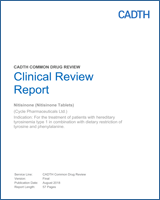Hereditary tyrosinemia type 1 (HT-1) is a rare, autosomal recessive disorder of amino acid metabolism. The deficiency of fumarylacetoacetate hydrolase (FAH), which is the last enzyme in the pathway of tyrosine catabolism, results in the accumulation of toxic metabolites in the FAH-deficient hepatocytes and proximal renal tubular cells and subsequently leads to liver and kidney damage. HT-1 typically manifests in infancy and is characterized by elevated plasma tyrosine levels. For children with HT-1 whose disease is not detected by the newborn screening, liver dysfunction (such as bleeding abnormalities, hypoglycemia, ascites, edema, vomiting, irritability, and jaundice) is the dominant clinical manifestation. Progression of the liver disease can be chronic or acute, with rapid deterioration. Without treatment, the lifetime risk of developing hepatocellular carcinoma (HCC) is as high as 37% in the survivors, according to previous research. Many patients also suffer from neurocognitive deficits. If untreated, the survival in patients with HT-1 is less than 12 months; most of these children die as a result of liver failure and severe coagulopathy. The prevalence of HT-1 ranges from 1 in 12,000 to 1 in 100,000 individuals of Northern European descent. In Canada, higher prevalence (1 in 1,846 live births) was observed in the Saguenay–Lac-Saint-Jean region in Quebec.
Nitisinone (Nitisinone Tablets) is a competitive inhibitor of 4-hydroxyphenylpyruvate dioxygenase, an enzyme upstream of FAH in the tyrosine catabolic pathway. It prevents the accumulation of the catabolic intermediates, which can be converted to the toxic metabolites, succinylacetone (SA) and succinylacetoacetate. The effect of nitisinone on inhibiting catabolism of tyrosine also leads to an increase in plasma tyrosine levels. Therefore, treatment with nitisinone requires restriction of the dietary intake of tyrosine and phenylalanine to prevent tyrosine toxicity.
Nitisinone Tablets received Health Canada approval based on the clinical studies for the reference product (Orfadin), which are the studies included subsequently in this review and which are based on data demonstrating bioequivalence with Orfadin (Appendix 5: Bioequivalence Study).
Funding: CADTH receives funding from Canada’s federal, provincial, and territorial governments, with the exception of Quebec.
Disclaimer: The information in this document is intended to help Canadian health care decision-makers, health care professionals, health systems leaders, and policy-makers make well-informed decisions and thereby improve the quality of health care services. While patients and others may access this document, the document is made available for informational purposes only and no representations or warranties are made with respect to its fitness for any particular purpose. The information in this document should not be used as a substitute for professional medical advice or as a substitute for the application of clinical judgment in respect of the care of a particular patient or other professional judgment in any decision-making process. The Canadian Agency for Drugs and Technologies in Health (CADTH) does not endorse any information, drugs, therapies, treatments, products, processes, or services.
While care has been taken to ensure that the information prepared by CADTH in this document is accurate, complete, and up-to-date as at the applicable date the material was first published by CADTH, CADTH does not make any guarantees to that effect. CADTH does not guarantee and is not responsible for the quality, currency, propriety, accuracy, or reasonableness of any statements, information, or conclusions contained in any third-party materials used in preparing this document. The views and opinions of third parties published in this document do not necessarily state or reflect those of CADTH.
CADTH is not responsible for any errors, omissions, injury, loss, or damage arising from or relating to the use (or misuse) of any information, statements, or conclusions contained in or implied by the contents of this document or any of the source materials.
This document may contain links to third-party websites. CADTH does not have control over the content of such sites. Use of third-party sites is governed by the third-party website owners’ own terms and conditions set out for such sites. CADTH does not make any guarantee with respect to any information contained on such third-party sites and CADTH is not responsible for any injury, loss, or damage suffered as a result of using such third-party sites. CADTH has no responsibility for the collection, use, and disclosure of personal information by third-party sites.
Subject to the aforementioned limitations, the views expressed herein are those of CADTH and do not necessarily represent the views of Canada’s federal, provincial, or territorial governments or any third-party supplier of information.
This document is prepared and intended for use in the context of the Canadian health care system. The use of this document outside of Canada is done so at the user’s own risk.
This disclaimer and any questions or matters of any nature arising from or relating to the content or use (or misuse) of this document will be governed by and interpreted in accordance with the laws of the Province of Ontario and the laws of Canada applicable therein, and all proceedings shall be subject to the exclusive jurisdiction of the courts of the Province of Ontario, Canada.

